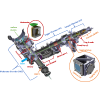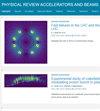Improving the beam quality of the low-energy muon beamline at Paul Scherrer Institute: Characterization of ultrathin carbon foils
IF 1.8
3区 物理与天体物理
Q3 PHYSICS, NUCLEAR
Physical Review Accelerators and Beams
Pub Date : 2024-05-30
DOI:10.1103/physrevaccelbeams.27.054501
引用次数: 0
Abstract
The low-energy muon (LEM) beamline at the Paul Scherrer Institute currently stands as the world’s only facility providing a continuous beam of low-energy muons with keV energies for conducting muon spin rotation experiments on a nanometer depth scale in heterostructures and near a sample’s surface. As such, optimizing the beam quality to reach its full potential is of paramount importance. One of the ongoing efforts is dedicated to improving the already applied technique of single muon tagging through the detection of secondary electrons emerging from an ultrathin carbon foil. In this work, we present the results from installing a thinner foil with a nominal thickness of and compare its performance to that of the previously installed foil with a nominal thickness of . Our findings indicate improved beam quality, characterized by smaller beam spots, reduced energy loss and straggling of the muons, and enhanced tagging efficiency. Additionally, we introduce a method utilizing blue laser irradiation for cleaning the carbon foil, further improving and maintaining its characteristics.

提高保罗-舍勒研究所低能μ介子光束线的光束质量:超薄碳箔的表征
保罗-舍勒研究所的低能μ介子(LEM)光束线是目前世界上唯一能提供连续μ介子束的设备,其μ介子能量为keV,用于在异质结构和样品表面附近进行纳米级的μ介子自旋实验。因此,优化光束质量以充分发挥其潜力至关重要。其中一项正在进行的工作是通过探测从超薄碳箔中出现的二次电子来改进已经应用的单μ介子标记技术。在这项工作中,我们介绍了安装标称厚度为 0.5 μg cm-2 的更薄碳箔的结果,并将其性能与之前安装的标称厚度为 2.0 μg cm-2 的碳箔进行了比较。我们的研究结果表明,光束质量得到了改善,光束光斑变小,μ介子的能量损失和杂散减少,标记效率提高。此外,我们还介绍了一种利用蓝色激光照射来清洁碳箔的方法,从而进一步改善和保持了碳箔的特性。
本文章由计算机程序翻译,如有差异,请以英文原文为准。
求助全文
约1分钟内获得全文
求助全文
来源期刊

Physical Review Accelerators and Beams
Physics and Astronomy-Surfaces and Interfaces
CiteScore
3.90
自引率
23.50%
发文量
158
审稿时长
23 weeks
期刊介绍:
Physical Review Special Topics - Accelerators and Beams (PRST-AB) is a peer-reviewed, purely electronic journal, distributed without charge to readers and funded by sponsors from national and international laboratories and other partners. The articles are published by the American Physical Society under the terms of the Creative Commons Attribution 3.0 License.
It covers the full range of accelerator science and technology; subsystem and component technologies; beam dynamics; accelerator applications; and design, operation, and improvement of accelerators used in science and industry. This includes accelerators for high-energy and nuclear physics, synchrotron-radiation production, spallation neutron sources, medical therapy, and intense-beam applications.
 求助内容:
求助内容: 应助结果提醒方式:
应助结果提醒方式:


